Ecuadorian Jungle – Adventures for Real Men
When I was 20 years old I read an amazing publication named The Whole Earth Catalog which was published by a guy from California called Stewart Brand. That rarity was made with the help of a typewriter, scissors and Polaroid in the 60s, when there were no personl computers yet. It was a kind of Google in paperback form, 35 years before Google appeared. It was idealistic and overflowed with great notions. Stewart and his team published only several issues of The Whole World Catalog prior to the final one in the middle of the 70s. On the back cover there was a photo showing a road in the early morning with the phrase: «Stay hungry, stay foolish» under it. That was the authors’ farewell. Since then I have always wished it to myself.
… The Galapagos Islands and the Pacific Ocean, cities with colonial Spanish architecture, the volcanoes Antisana, Cayambe, Kotopaxi and Chimborazo with heights from 5500 to 6300 m.
At that time I had the opportunity to visit a very exotic country — Ecuador. The mountains and ocean are beautiful, of course, but, despite their beauty, they are quite usual. What I really wanted was to experience something new and unusual, for example, walking in the equatorial jungle.

There are two ways to get to the jungle from Quito, the country capital — the city with 500 years history. The first way is by regular bus; it is cheap, but rather dangerous because of possible robbery and the route running along an extremely winding road. The cost of a one way trip is about $20. By the way, all the prices are expressed in US dollars since there has been no local currency in Ecuador for more than 10 years. The second, but more expensive, way is by travelling on a small plane of one of the local air companies.
There are two national parks in Ecuador (they are called natural reserves there): Cuyabeno and Yasuni. These names didn’t mean anything to us, so we chose the remotest location on the map — the national reserve Cuyabeno, located not far from Ecuador’s oil capital — Lago Agria.
We went to the airport from the hotel in the tourist center of the capital by taxi, which cost us $6.
It was raining and the temperature was +10. Such a strange summer. We chose the VIP air company and upon completion of all formalities and a 40 minute flight we found ourselves in a remote Ecuadorian province called Lago Agria. At Samona Lodge (named after an endemic tree) there were 10 people: Dutch, English, Belgians and Germans — a real international team. After a 2 hour trip on a local bus, we arrived at the control point at the entrance of the National Park located not far from Tarapoa village. Various thoughts appeared in my mind on the way: from possible robbery (when a bus is stopped by armed people, which happens often in this region of the country on the border with Columbia) to the possibility of being sent to work at the cocaine plantations of the successors of Pablo Escobar.
At the park office we paid $2 and were registered. The admission fee to the park has decreased recently in order to meet the tourists’ wishes. Galapagos Archipelago is the only exception with a $100 admission fee.
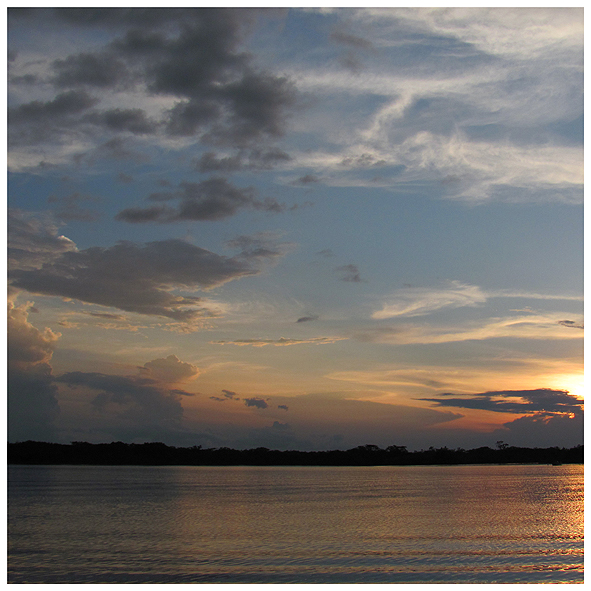
Further we were to travel by river. We were accompanied by two guides Kairo and Miguel. We got into long motor boats and sailed for three hours until we arrived at our lodge. People are not allowed to sail on the rivers and the Cuyabeno Lake all year round, but only during sailing seasons. You should ask your travel agency in advance whether it is possible to sail there, even if you are not going to use their services. The speed of travel along the river depends on how loaded the boat is, on the level of the water and on how adventurous Señor Motorman is. You’ll see a lot of interesting animals overboard – herons, rare falcons, monkeys, bats, tropical chickens hoatzins, two-meters long caimans, butterflies and even anacondas.
Our lodge was an excellent example of ecological tourist accommodation. It was located on the bank of the Cuyabeno River, which is a tributary of the Napo River being in its turn a tributary of the Amazon River. The nearest village is located in 45 km away, and the nearest lodge in 5 km. Both places are accessible only by water because there are no roads in the area.
The lodgeconsists of 10 houses standing on piles, outbuildings and a dining room which is used as a kitchen at the same time. The water is taken from the rivers, purified and supplied to the shower room and toilet; this water is not for drinking and it is recommended that people brush their teeth and wash themselves only with bottled or boiled water. The used water is refined again in septic tanks and discharged back into the river.
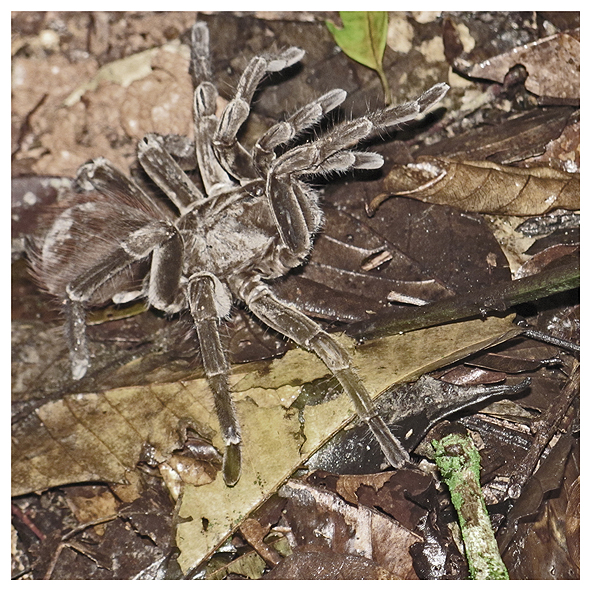
The lodge service package includes meals, tea, coffee, water, rubber boots and all-weather raincoats (poncho); bar is is paid for separately. Electricity is supplied by electric accumulators only to the kitchen, while the rooms (three in each cottage) are lit by candles installed in porch, toilet and over the bed. Every porch has a hammock and a mosquito net over the beds. The meals are very good: river fish, fried bananas, yucca – the local analogue of potatoes, rice, lots of fruit and fresh juice.
You’ll be surrounded by the sounds of the tropical forest there, as well as by huge flying cockroaches, poisonous frogs in the shower, and huge hairy tarantulas over the bed. It is really funny!
Before dinner we travelled by boat to the Cuyabeno Lagoon. This is the second largest protected water reserve in the tropical part of the country. It is a reserve with 100% wildlife. We jumped off the boat and swam in the lagoon. Lightnings were flashing in the distance, while huge trees were sticking out of the water. The depth was about 2.5 m, the «dry» season was coming and the water level in the river and the lake was decreasing gradually. Then we got into the boat and our guide, Kairo, started telling us horror stories about piranhas and electric eels, accidents and so on. Since then we always look at water with caution.
This lake does not exist all year round, it appears only during the high water season. In such periods, trees stand in the middle of the lake, pink dolphinsswim between them eatingpiranhas,piranhas eat dolphins and people catch piranhas. When thewater level falls, this huge lake turns into an impassable swampwith caimans and birds breeding in it. But then the high water comes again …
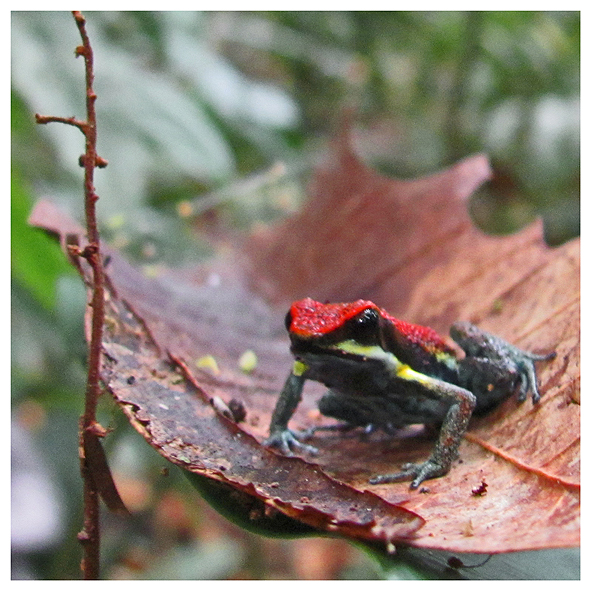
While we were swimming we didn’t notice how quickly it became dark. We sailed to the thicket to look for caimans in the light of lanterns. We saw a couple of caimans with their eyes reflecting the light of our lanterns. Our guide nearly caught one of them by the tail.
By the way not everyone can become a guide. Each guide must complete special training courses, pass practical training and obtain the corresponding certificate. Our guide, Kairo, had a degree in ecology. He also could imitate the sounds of the local birds and animals. Guides are taught to do this in training courses.
When we were sailing back Kairo saw a fish in the light of a lantern, he took out a machete and cut it in 2 halves. He said that this was the best fishing method there. That fish was fried and served for dinner. During the dinner the members of our team got acquainted with each other in a casual atmosphere. The «local residents» brought a guitar and — Oh, how small the world is! — started singing the famous hit about “the crushed body with sky-blue eyes lying on rails…” in Spanish with a similar mournful voice. I took the guitar too and sang my friend’s scabrous song named Sex for Food!. Everybody liked it and started to sing along. Then I had to translate it and everybody liked it even more. Interesting stories, easy going people and language practice. Many of them liked hearing about Kazakhstan.
On the next morning we did morning exercises at the porch, had breakfast and went back to the lagoon. We saw parrots in the hollows of tree trunks sticking out of the water. Usually male parrots guard their hatching females. We saw also a water snake and pink dolphins. The indians sometimes catch dolphins to get their natural fat. Peruvian Indians attract dolphins by an old artful method: they put a pipe with a sliver in it into the water and beat the pipe producing sounds similar to dolphins mating calls. Then the dolphins are fed with fish and stricken by a harpoon.
After landing we roamed for two hours in the jungle wearing rubber boots — a kind of natural scientist’s trip. Ants, cicadas, frogs, spiders, lianas, trees, lichens, unknown animal’s tracks on unknown paths, humidity and mosquitoes. Our guide beat bee hives with a stick just for fun — bees enmeshed in the hair and bit us. Although their bites were not very painful, they were quite vexing. The funniest part was walking in the champing swamp. Some people even got stuck in the mud up to their knees.
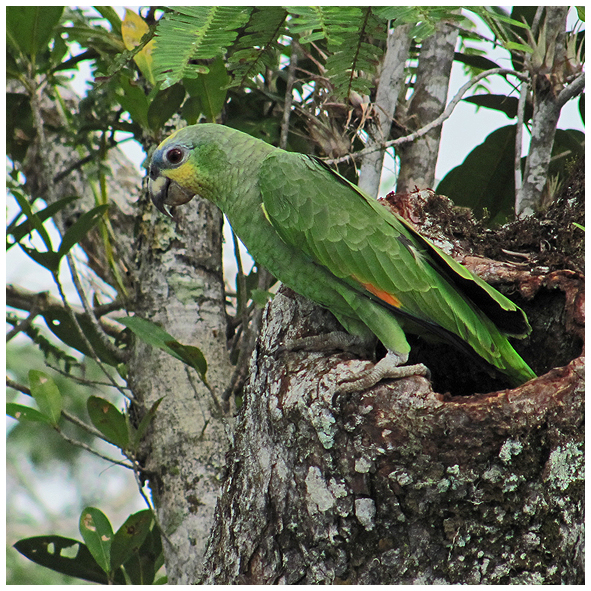
When we came to the bank of the river, we washed our boots and decided to watch anacondas and swim. But as it happens, in the tropics usually the sky opened wide suddenly and it started to rain so heavily that we had to hurry back «home» while bailing out the boat on the way. After a siesta, we planned to go to catch piranhas and walk in the night forest in search of big spiders.
During the dinner our guide told us about a group of Ukrainian and Russian tourists who came to Cuyabeno to drink the local drink made by shamans rather than to enjoy watching the nature. This drink is called «ayahuasca», which is translated from the Quechua language as «the vine of the dead» or «the vine of the souls». This drink is a psycho-stimulant made by the people living in the Amazon River region. The main ingredient of this drink is a kind of vinenamed «banisteriopsis caapi». It is similar to wine and includes several alkaloids evoking hallucinations such as lights, sounds, smells and creatures. Its effect lasts for 3 hours. Shamans sell the drink for $10 per glass. Some people drinking it become inadequate, scream and run waving their hands. However, the main effect of it is to clean the organism through, I beg your pardon, all natural orifices. Kairo told us that he had used to drink it 2-3 times a month, but gave up when he «saw the future».
Our piranha fishing failed. We caught only two small fishes, one edible and one inedible. We caught them with fishing rods fit only with a fishing line with bait on it — a piece of fresh beef without a plummet and a float. When fishing with such fishing rod you need to stir the water with the end of the rod in order to attract fish. Piranhas are rather smart and they very seldom swallow the bait, as usual they just take the meat. Kairo showed us some small bite scars.
After fishing we went walking in the night jungle. In the evening we listened to stories about the Amazon region, the war between Peru and Ecuador for that region which took place in 1942. The reason for that war was a dispute for the territory located mainly in the Amazon region between the mountain range Andes and the Maranon River. The dispute over the territory started as early as the colonial period; several military conflicts took place during the XIX and XX centuries between Peru and the Great Columbia and between Peru and Ecuador after the collapse of the Great Columbia. Several times the parties tried to settle the dispute in a peaceful manner, but those attempts failed.
We were also told about the flow of tourists: up to 1 million tourists come to the country with a population of 13 million people; tourists come mainly from the USA, Europe, Australia and South Africa. However, the number of Russian tourists is increasing every year. There are no any statistical data concerning the number of tourists from Kazakhstan, so they can start counting from me.
On the next morning we got into the boat again and went to the nearest Indian village. The bank was high at that place, which is why houses were installed on piles. 150 Sekoya Indians live in that village. The second similar nationality is called Siona. They have electricity, television and internet there. Unlike Guarani Indians living in the neighboring Isuni province, the local people wear clothes similar to those worn by civilized people. All the blessings of civilization are sponsored by oil companies carrying out exploratory operations in that region. The government obliged them to support the local population. The internet is used only by children for educational purposes. Each villager has the right to own 2 hectares of land, but not all of them exercise this right. The local people’s demands and needs are not very high. Indians also grow cocoa on the government order.
We were shown how yucca (cassava) grows, how it is harvested and how bread is made from it. Bread is the main food product for the local people. Sometimes they also eat game meat. Not to mention fruit —there are lots of fruit there, for any taste. I’d like to say a little about baking bread. The rhizome (tuber) is peeled, washed and grated. Then the produced paste is pressed and sifted. Finally, it is baked on a big flat round shaped brazier placed above the fire without adding water, salt or milk. Its taste is not similar to that of our bread. As a result of eating cassava continuously, Indians are plump, which makes them look rather funny with their small height. While I was writing about bread I found a very poetical description of the nearby Yasuni park. Here is the link for those interested: http://community.livejournal.com/macondo_ru/84237.html.
So let’s go back to the village. All the boats used by travel agencies belong to the local people who lease them. In the village there is a night shop and a garden-house beside it with beer bottle corks scattered all around. There is also a football pitch. Toilets in the village are fit with usual toilet bowls but without water.
We felt like primitive hunters after shooting blowguns, a rather accurate weapon with shooting range of 50 m. The local people use poisoned darts to hunt for monkeys and birds. We painted our faces with the juice of some exotic fruit. My face and beard were painted red. We provided financial support to the local community: we bought beads for $2, a bracelet made from iguana skin for $5, which is said to be effective in relieving headache, and paid $2 per person for the baking bread attraction.
A remarkable part of our journey was the visit to the widely known 71 years old shaman Alberto who lives in isolation down the stream. Despite the prevalence of Catholicism, the local people prefer to go to shamans for healing.
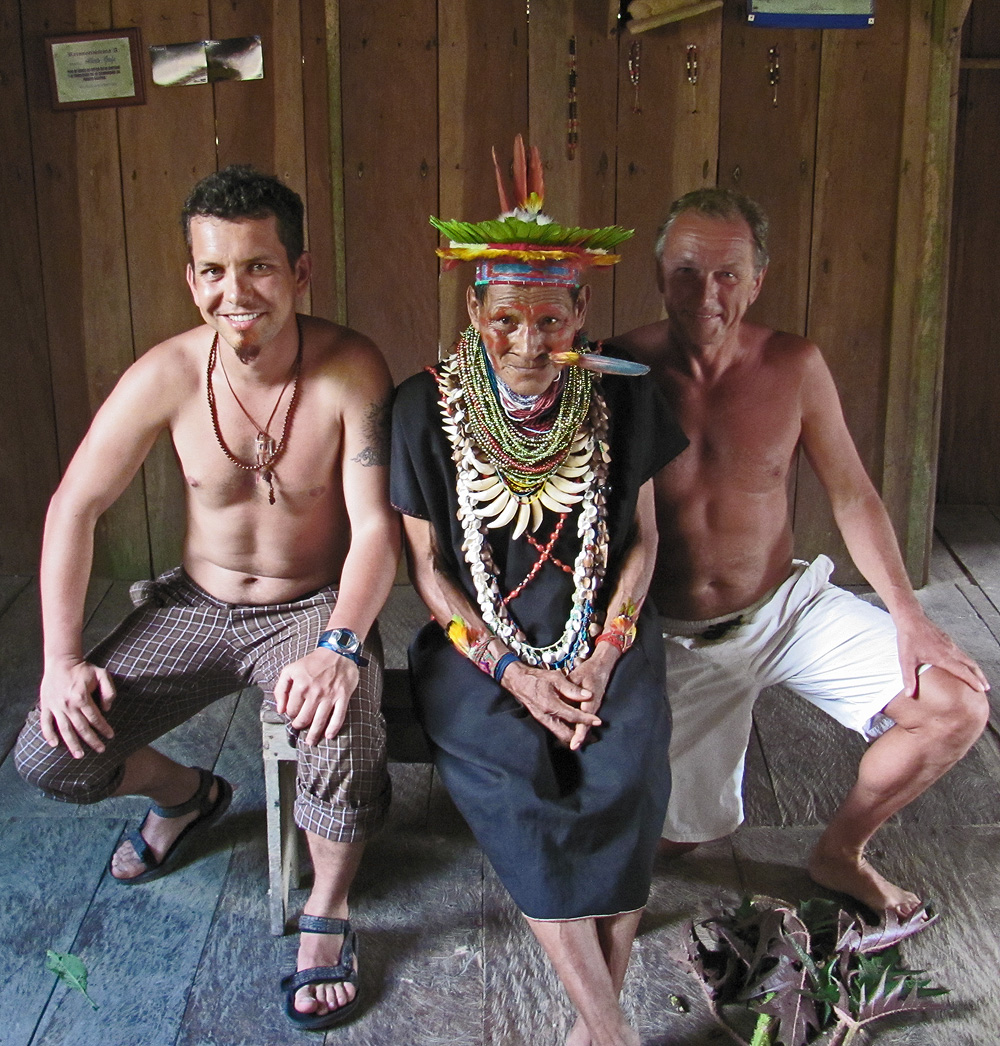
Alberto was taught by several old shamans for a long time. He adopted their methods and only started to teach and cure other people when he was 40. Nowadays he has several western students and one student from Russia. He looks very unusual — he wears a crown made from parrots feathers, a necklace from shells and jaguar teeth and a simple knee-length tunic. He had clear cunning eyes and a well trained voice, he speaks academic Spanish. He didn’t look like he was 71 years old, but maximum 55. He said that his grandfather had lived 182 years but modern shamans have degenerated and do not live that long.
All modern shamans, including Alberto, have state certificates which usually hang on the wall in the room for ceremonies and rituals. Shamans do not study only plants, they are also taught to drink special drinks that allow them to communicate with spirits, leave their bodies and so on. Shamans prepare such special drinks in a special manner: they brew them and cast spells over them. Many Europeans have tried to prepare their own drinks. Most of them went off their trolley…
Shamans cure in 3 stages as I understood. The 1st stage is the determination of disease, the 2nd stage — determination of the necessary treatment, and the 3rd — work with energies. The Shaman drinks his potion, falls into a trance and determines the disease by the skin colour or glow.
I sat on a stump. Alberto started to fan me with some leaves and sing a song in order to clean my spirit. Then Alberto laid my fellow traveler and me on the same stump in a prone position and beat our naked backs with the local analogue of nettle. Our backs were covered in blisters which disappeared soon. The Shaman said that it was good for the blood circulation. All our group members enquired about our feelings and health with sympathy after that. No one dared to undergo that procedure except for us. «Crazy Russians» saved everybody again. After Alberto’s execution we were allowed to take photos for $2 only.
In Don Alberto’s yard we saw a real coca bush which was not distinguished by its appearance, but had very healthy effects. That’s why Bolivians and other peoples continuously chew coca leaves.
Before dinner we went to the lagoon again in order to swim and take photos. It was warm and beautiful, but suddenly a heavy shower started again. No one had brought their ponchos that time and Tomas, the motorman, drove the boat back home. Big drops were lashing our tormented bodies. The wind was blowing in our faces. Incredible!
In the evening I spoke with Kairo again. That time we discussed life, women and his job. It turned out that there are three levels of proficiency. Kairo had the second one and in order to obtain the third one he needed to learn a second foreign language (German). He was 30 years old, unmarried but with a big family which he was supporting financially. He lived in Lago Agria and studied under the state program in the biggest city of the country, Guayaquil. He was working at several travel agencies at the same time. He didn’t say anything about his salary.
Since that was our last night in the jungle, the lodge personnel regaled us with a local cocktail, Cuyabeno Libre. We asked Kairo to tell us a local horror story. He told one rather banal story, which I’ll garble for sure due to translation problems. One Ecuadorian person said that it is hard to find a Russian speaking guide to accompany you in the mountains, while the Ecuadorian guides speaking English often talk through their hat due to the same translation problems.
So here is the story. In days of yore there was a small community in the jungle. There was a family in that community — mother, father, grandfathers, grandmothers, brother and sister. One young person got the habit of coming to the daughter’s room and sleeping with her. Since it was very dark she could not recognize him. One night, another.. Finally she fell in love with him. Then she asked her grandmother’s advice. Grandmother told her to place a plate with indelible henna under her bed and cover the admirer’s face with it in the middle of the night in order to be able to recognize him in the daytime. The girl followed the advice. But in the daytime she didn’t see any person with painted face in the village. Meanwhile, her brother at home was hiding his face. Thus everything was revealed. Their parents ordered them to marry each other and live separately. The sister was happy, while the brother was not. He had wanted to leave the community for the big world long ago and was just waiting for the right occasion. The only way was to make a big kite from web, launch it from the highest Samona tree and fly away on it. The guy tormented himself for a while and finally launched the kite and flew away in the fool moon. The sister saw that and ran after him crying and weeping. But the guy was firm on his purpose, uncompromising and imperturbable. The girl cried inconsolably under the tree. The spirit of the treet got tired of her cry and turned the guy into a bird named in Indian «mother of the Moon» (I didn’t see a logic connection there). Since then the girl has been inconsolable and the bird still screams in the fool moon, although it isn’t silent in usual nights.
On the next morning, the guide, the boatman and other personnel of the lodge got their deserved tip. We got onto the boat again, sailed to the bridge, and then went to Lago Agria airport. But it turned out that the airport wasn’t receiving any flights that moment because of a failure in the fire-extinguisher system. We were told that the specialist had departed from Quito, so we had to wait till he arrived, determined the reasons of the failure and repaired the system… The VIP company (very encouraging name) didn’t offer anything else but flying in the next day’s flight from the nearest (150 km) «big» city Coca. We had to pay for the cost of travel and hotel accommodation by ourselves, but our tickets were reissued for free.
We went to Coca on the Napa River by bus for $3 and moved in a hotel there. There was no hot water, but the hotel was clean and the rooms cost only $20. We went for dinner to the recommended restaurant Lonely Planet in the hotel. At the porch we enjoyed the views of that tributary of the Amazon River and the huge bridge that was under construction. A Dutchman called Darek connected to the Internet on his I-phone and showed his home city covered with snow. So there was enough food for thought, three weeks in Ecuador came to the end. We had to fly over the Atlantic to the center of Eurasia, back to traffic jams, smog, families and new plans.